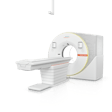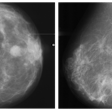Sectra Imtec
PACS security will be a key theme this year for Swedish firm Sectra, which will display version 5 of its IDS workstation series. The new series contains workstations tailored for every user of radiological images, including radiologists, x-ray technologists, and clinicians, according to the firm. This provides a homogeneous viewing environment throughout the enterprise, with uniform user interface, user handling, authentication and access control, and worklists, according to Sectra.
New features on IDS5 include a fingerprint log-in capability. By putting a finger on the fingerprint reader, the user immediately gets identified, logged in, and gains access to his or her personal settings and worklists. Default display protocols have been incorporated, allowing users throughout the enterprise to avoid manual "hanging" of images on each system. In addition, Sectra has added a feature it calls cross-platform worklist, which creates one common worklist from the Sectra PACS database and legacy systems.
Voice recognition has also been added, thanks to integration with Talk Technology's products. Sectra has also introduced what it calls a Zero Administration Concept with IDS5. With this approach, installation and workstation upgrades are now performed automatically. Upgrades are sent to the server, which automatically updates all client workstations as they launch.
In other PACS technology introductions, Sectra is introducing LitePACS, a turnkey single-server product that runs on the Windows 2000 operating system. Targeted for small and mid-size enterprises, LitePACS can be upgraded to a distributed multiserver ModularPACS, if desired.
In ModularPACS developments, Sectra has added ImageServer/fs long-term RAID archiving capability. Sectra technology can be seen in its own RSNA booth, as well as in the booth of its partner, Philips Medical Systems.
Siemens Medical Systems
Siemens will highlight the benefits to customers of the company's recently completed acquisition of information systems developer Shared Medical Systems. Siemens in particular will highlight the expertise SMS has developed in the ASP realm.
On the PACS side, Siemens will demonstrate work-in-progress developments in integrating PACS with HIS networks, optimizing workflow, and laying the groundwork for the electronic patient record.
Siemens and SMS will also demonstrate the use of thin-client applications to get images to referring physicians via Web-based applications.
Stentor
The big news at Stentor is the company's just-announced alliance with healthcare information systems provider IDX Systems of Burlington, VT. On November 16 the companies said they intended to develop a fully integrated medical image and information management system on the ASP model. The firms will combine the IDX Imaging Suite and ConnectR HIS/RIS interface with Stentor's iSite image delivery software to build the system -- which they say will lead the industry in both innovation and functionality. IDX has been mostly information-based, while Stentor has focused on image distribution, so the match could be a good one for both companies.
Stentor rolled into last year's RSNA meeting with iSyntax, a data distribution technology that enables fast, diagnostic-quality distribution of medical images in a low-bandwidth environment. The product is easily integrated with existing hospital networks, but no network infrastructure is required to use the system, according to the South San Francisco, CA, company.
Just before last year's meeting, the FDA had cleared the company's suite of products known as iSite, the server and Web-based browser application that forms the core of Stentor's pay-per-use ASP model. South San Francisco, CA-based Stentor makes the iSite suite available to facilities free on a 30-day trial basis, then charges the client on a per-study basis.
Stentor released version 1.0 of the iSite software in June, and concurrently released the iSite product for commercial sale throughout the U.S. In order to ensure system reliability, the software contains a computer-diagnostic monitoring system known as Heartbeat that signals more than 50 potential error conditions in the network, disk, power supply, CPU failure, DICOM and connectivity, Stentor said.
According to company spokesman Mark Reis, about 25 clients are currently somewhere in the continuum between trial and paid use of the system. The company has landed several important clients, such as the MD Anderson Cancer Center, in Houston; Kaiser Permanent of Northern California in Oakland; the VA Medical Center in Ann Arbor, MI; and Inland Imaging in San Francisco, Reis said.
Last month the company received second-round financing in the amount of $20 million, to be used for product expansion, R&D, engineering and customer service enhancements.
Toshiba America Medical Systems
Toshiba will highlight its SimPACS partnership with Agfa. With SimPACS, Toshiba offers modality-level miniPACS networks to its customers, and refers customers looking for larger enterprise-wide systems to Agfa. Toshiba plans to emphasize the fact that users can upgrade from SimPACS to an Agfa PACS, with their investment in SimPACS being credited toward the Agfa purchase, according to Toshiba.
By Erik Ridley, Brian Casey, Eric Barnes, and Jonathan S. Batchelor
AuntMinnie.com staff writers
November 16, 2000
Go to page:
Agfa through Amicas
Artesian through DR Systems
Dynamic through Inphact
InsiteOne through Rogan
Sectra through Toshiba
Copyright © 2000 AuntMinnie.com



















